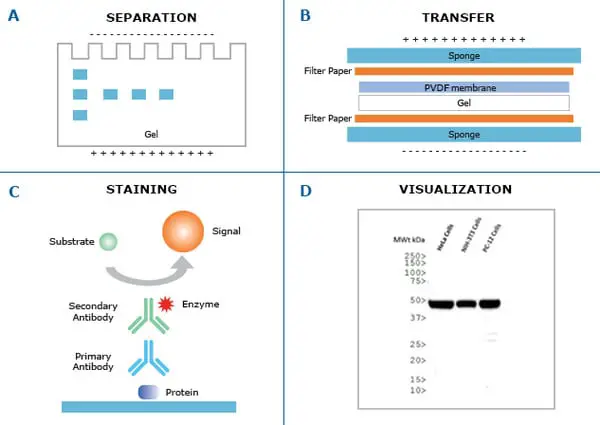
The membrane is incubated with a nucleic acid probe that has a sequence homologous to the target sequence and is labeled with radioactivity, fluorescent dye, or an enzyme capable of generating a chemiluminescent signal. Following electrophoresis, the DNA on the gel is transferred to a nylon membrane. Smaller fragments will migrate farther on the gel than larger ones. The fragments are separated by size on an agarose or polyacrylamide gel via electrophoresis. The southern blot protocol begins with DNA extraction from the cells or tissues, which is then enzymatically digested to produce DNA fragments. Southern blots are used to determine the identity, size, and abundance of specific DNA sequences. Blotting techniques are selected based on the target molecule: DNA, RNA, or protein. This enables radiolabeled or enzymatically labeled antibody or DNA probes to bind the immobilized target, and the molecules of interest may then be visualized with various methods. Southern, northern, and western blot protocols are similar, and begin with electrophoretic separation of protein and nucleic acid fragments on a gel, which are then transferred to a membrane (nitrocellulose membrane, polyvinylidene difluoride (PVDF) membrane, etc.) where they are immobilized. Southern blotting: a laboratory technique used to detect a specific DNA sequence in a blood or tissue sample.PDF Version What’s the difference between a Southern, Northern, and Western Blot?ĭifferent blotting techniques are used to identify unique proteins and nucleic acid sequences. Gel electrophoresis is a technique used to separate DNA fragments according to their size Polymeric: a large/gigantic molecule that is made up of repeating, small molecules called monomers. Nucleotide : a building block molecule of nucleic acids.

The nucleic acid fragments that are bound to the surface of the membrane can then be probed with specific radioactively- or fluorescently-labelled probe sequences. The fragments in the gel are then transferred onto a nylon membrane in a procedure called blotting. Gel electrophoresis separates the nucleic acid fragments according to their size. Short DNA fragments called probes are designed and labeled with radioactive or fluorescent dyes to aid detection. Nucleic acid samples, such as fragmented genomic DNA and RNA extracts, can be probed for the presence of certain sequences. See the example gel electrophoresis result below. Finally, distinct nucleic acid fragments appear as bands at specific distances from the top of the gel (the negative electrode end) based on their size. Nucleic acids in a gel matrix can be observed using various fluorescent or colored dyes. Researchers use molecular-weight standard DNA samples that can be run alongside the molecules to provide a size comparison and identify the DNA fragment of known size.

Smaller molecules move through the pores in the gel faster than larger molecules this difference in the rate of migration separates the fragments based on size. The polymeric gel has porous structures thus acts as a molecular sieve. Samples are loaded into a slot near the negative electrode and pulled toward the positive electrode at the opposite end of the gel.

Because nucleic acids are negatively-charged ions at neutral or basic pH in an aqueous environment, an electric field can mobilize them. For that, nucleic acid samples are run through a polymeric gel matrix under the electric field. the number of nucleotides) in a sample and visualize them. Gel electrophoresis allows to separate the nucleic acid molecules of various length (i.e.

Gel Electrophoresis and Southern blotting are techniques used to characterize DNA samples.


 0 kommentar(er)
0 kommentar(er)
